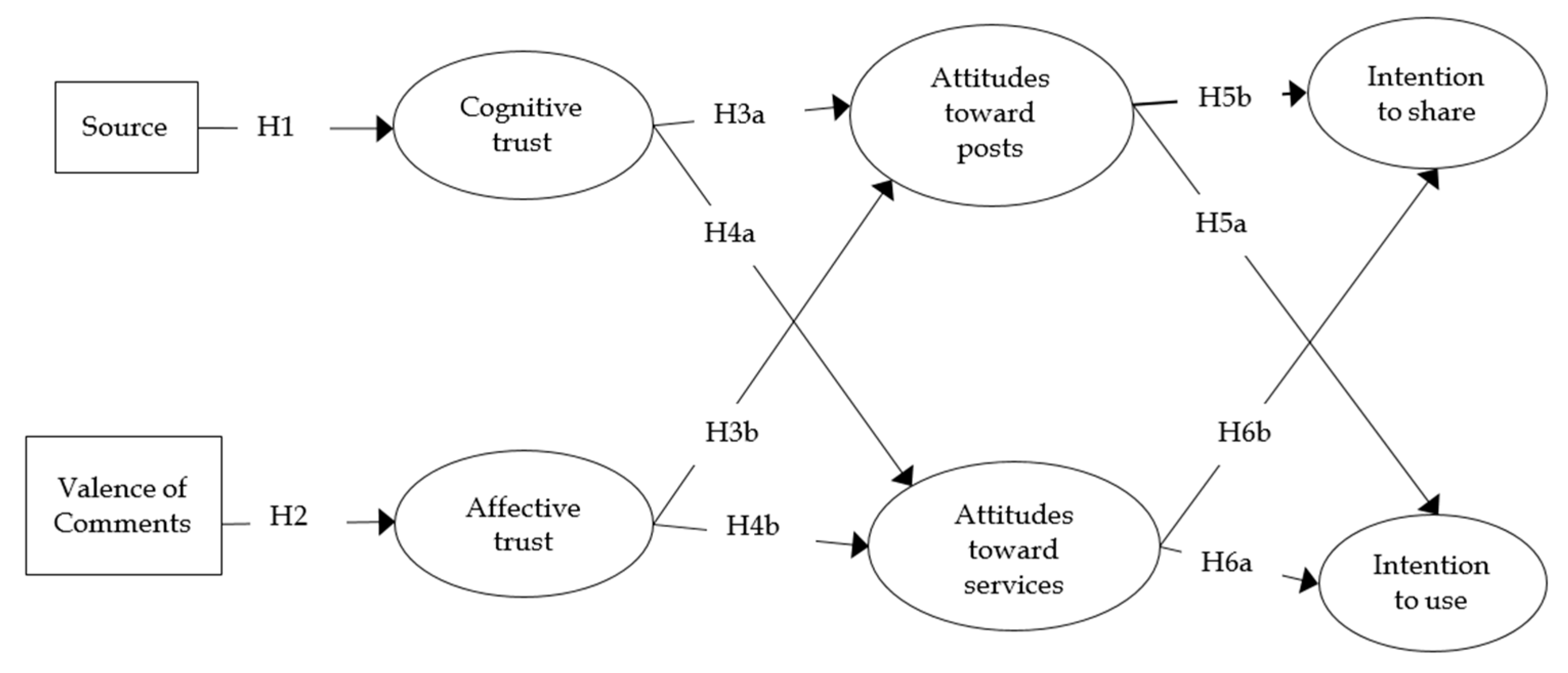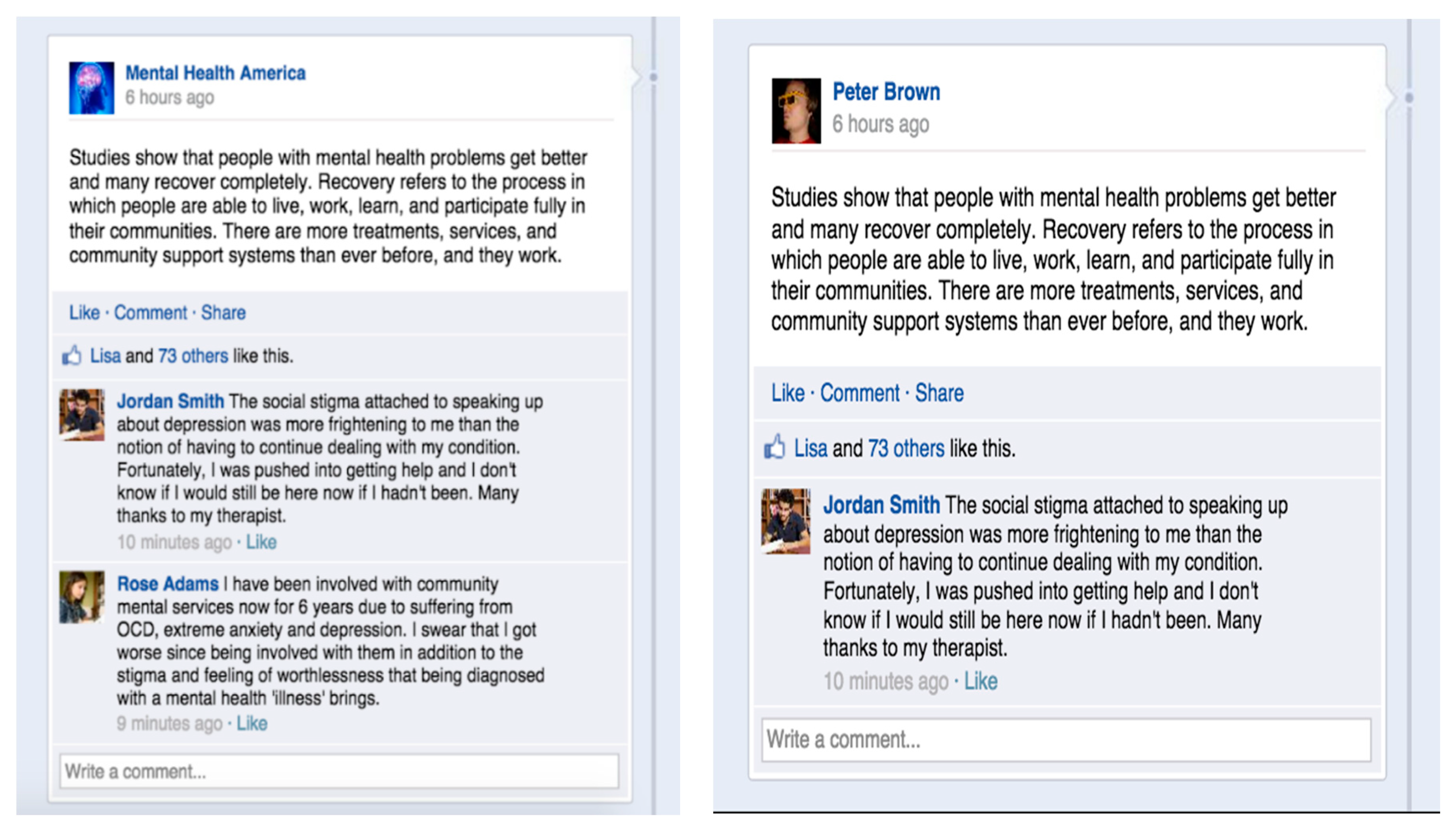An Experimental Investigation into Promoting Mental Health Service Use on Social Media: Effects of Source and Comments
Abstract
1. Introduction
1.1. Mental Health and Social Media
1.2. The MAIN Model and Cues
1.3. Dimensions of Trust, Cues and Cognitive Perceptions
1.4. Research Questions and Hypotheses
2. Methods
2.1. Design Overview
2.2. Participants and Procedure
2.3. Experimental Treatment Conditions
2.4. Measurements
2.4.1. Manipulation Checks
2.4.2. Mediating Variables
2.4.3. Dependent Variables
2.5. Data Analysis
3. Results
3.1. Sample
3.2. Results of SEM
4. Discussion
4.1. Health Applications
4.2. Design Applications
4.3. Limitations and Future Directions
5. Conclusions
Author Contributions
Funding
Conflicts of Interest
References
- National Institute of Mental Health (NIMH). Mental Illness. 2020. Available online: https://www.nimh.nih.gov/health/statistics/mental-illness.shtml (accessed on 27 September 2020).
- National Institute of Mental Health (NIMH). Chronic Illness & Mental Health. 2020. Available online: https://www.nimh.nih.gov/health/publications/chronic-illness-mental-health/index.shtml (accessed on 27 September 2020).
- National Alliance on Mental Illness (NAMI). 2016. Available online: http://www.nami.org/Learn-More/Mental-Health-By-the-Numbers (accessed on 6 March 2020).
- Livingston, J.; Cianfrone, M.; Korf-Uzan, K.; Coniglio, C. Another time point, a different story: One year effects of a social media intervention on the attitudes of young people towards mental health issues. Soc. Psychiatry Psychiatr. Epidemiol. 2014, 49, 985–990. [Google Scholar] [CrossRef]
- Naslund, J.A.; Aschbrenner, K.A.; Marsch, L.A.; Bartels, S.J. The future of mental health care: Peer-to-peer support and social media. Epidemiol. Psychiatr. Sci. 2016, 25, 113–122. [Google Scholar] [CrossRef]
- Singleton, A.; Abeles, P.; Smith, I.C. Online social networking and psychological experiences: The perceptions of young people with mental health difficulties. Comput. Hum. Behav. 2016, 61, 394–403. [Google Scholar] [CrossRef]
- Aro, J. The cyberspace war: Propaganda and trolling as warfare tools. Eur. View. 2016, 15, 121–132. [Google Scholar] [CrossRef]
- Allcott, H.; Gentzkow, M. Social media and fake news in the 2016 election. J. Econ. Perspect. 2017, 31, 211–236. [Google Scholar] [CrossRef]
- Kang, H.; Sundar, S.S. When Self is the Source: Effects of Media Customization on Message Processing. Media Psychol. 2016, 19, 561–588. [Google Scholar] [CrossRef]
- Hu, Y.; Sundar, S.S. Effects of online health sources on credibility and behavioral intentions. Commun. Res. 2010, 37. [Google Scholar] [CrossRef]
- Johnson, D.S.; Grayson, K. Cognitive and affective trust in service relationships. J. Bus. Res. 2005, 58, 500–507. [Google Scholar] [CrossRef]
- Clement, S.; Schauman, O.; Graham, T.; Maggioni, F.; Evans-Lacko, S.; Bezborodovs, N.; Morgan, C.; Rüsch, H.; Brown, J.S.L.; Thornicroft, G. What is the impact of mental health-related stigma on help-seeking? A systematic review of quantitative and qualitative studies. Psychol. Med. 2015, 45, 11–27. [Google Scholar] [CrossRef]
- Armstrong, L.L.; Young, K. Mind the gap: Person-centred delivery of mental health information to post-secondary students. Psychosoc. Interv. 2015, 24, 83–87. [Google Scholar] [CrossRef]
- Yung, A.R. Youth services: The need to integrate mental health, physical health and social care. Soc. Psychiatry Psychiatr. Epidemiol. 2016, 51, 1–3. [Google Scholar] [CrossRef] [PubMed]
- Chaiken, S.; Maheswaran, D. Heuristic processing can bias systematic processing: Effects of source credibility, argument ambiguity, and task importance on attitude judgment. J. Personal. Soc. Psychol. 1994, 66, 460–473. [Google Scholar] [CrossRef]
- Medicine, J.H.; Mental Health Disorder Statistics. Online Health Library. 2016. Available online: http://www.hopkinsmedicine.org/healthlibrary/conditions/mental_health_disorders/mental_health_disorder_statistics_85,P00753/ (accessed on 6 August 2019).
- Metzger, M.J.; Flanagin, A.J. Credibility and trust of information in online environments: The use of cognitive heuristics. J. Pragmat. 2013, 59, 210–220. [Google Scholar] [CrossRef]
- Reavley, N.J.; Mackinnon, A.J.; Morgan, A.J.; Alvarez-Jimenez, M.; Hetrick, S.E.; Killackey, E.; Nelson, B.; Purcell, R.; Yap, B.H.; Jorm, F. Quality of information sources about mental disorders: A comparison of Wikipedia with centrally controlled web and printed sources. Psychol. Med. 2012, 42, 1753–1762. [Google Scholar] [CrossRef]
- Sundar, S.S. The MAIN Model: A Heuristic approach to understanding technology effects on credibility. In Digital Media, Youth, and Credibility; Metzger, M.J., Flanagin, A.J., Eds.; MIT Press: Cambridge, MA, USA, 2008; pp. 72–100. [Google Scholar]
- Mcknight, D.H.; Chervany, N.L. What Trust Means in E-Commerce Customer Relationships: An Interdisciplinary Conceptual Typology. Int. J. Electron. Commer. 2001, 6, 35–59. [Google Scholar] [CrossRef]
- McAllister, D.J. Affect- and Cognition-Based Trust as Foundations for Interpersonal Cooperation in Organizations. Acad. Manag. J. 1995, 38, 24–59. [Google Scholar]
- Corritore, C.L.; Kracher, B.; Wiedenbeck, S. On-line trust: Concepts, evolving themes, a model. Int. J. Hum. Comput. Stud. 2003, 58, 737–758. [Google Scholar] [CrossRef]
- Wang, W.; Qiu, L.; Kim, D.; Benbasat, I. Effects of Rational and Social Appeals of Online Recommendation Agents on Cognition- and Affect-based Trust. Decis. Support Syst. 2016, 86, 48–60. [Google Scholar] [CrossRef]
- Chua, R.Y.J.; Ingram, P.; Morris, M.W. From the head and the heart: Locating cognition-and affect-based trust in managers’ professional networks. Acad. Manag. J. 2008, 51, 436–452. [Google Scholar] [CrossRef]
- Edell, J.A.; Chapman, B.M. The Power of Feelings in Understanding Advertising Effects. J. Consum. Res. 1987, 14, 421–433. [Google Scholar] [CrossRef]
- Lewis, J.D.; Weigert, A. Trust as a social reality. Soc. Forces 1985, 63, 967–985. [Google Scholar] [CrossRef]
- Koh, Y.J.; Sundar, S.S. Heuristic Versus Systematic Processing of Specialist Versus Generalist Sources in Online Media. Hum. Commun. Res. 2010, 36, 103–124. [Google Scholar] [CrossRef]
- Kareklas, I.; Muehling, D.D.; Weber, T.J. Reexamining Health Messages in the Digital Age: A Fresh Look at Source Credibility Effects. J. Advert. 2015, 44, 88–104. [Google Scholar] [CrossRef]
- Walther, J.B.; DeAndrea, D.; Kim, J.; Anthony, J.C. The influence of online comments on perceptions of antimarijuana public service announcements on YouTube. Hum. Commun. Res. 2010, 36, 469–492. [Google Scholar] [CrossRef]
- Ahn, H. The Effect of Online News Story Comments on Other Readers’ Attitudes: Focusing on the Case of Incongruence between News Tone and Comments. Ph.D. Dissertation, University of Alabama Libraries, Tuscaloosa, AL, USA, 2011. [Google Scholar]
- Houston, J.B.; Hansen, G.J.; Nisbett, G.S. Influence of user comments on perceptions of media bias and third-person effect in online news. Electron. News 2011, 5, 79–92. [Google Scholar] [CrossRef]
- Jones, L.W.; Sinclair, R.C.; Courneya, K.S. The Effects of Source Credibility and Message Framing on Exercise Intentions, Behaviors, and Attitudes: An Integration of the Elaboration Likelihood Model and Prospect Theory1. J. Appl. Soc. Psychol. 2006, 33, 179–196. [Google Scholar] [CrossRef]
- Marton, C.; Choo, C.W. A review of theoretical models of health information seeking on the web. J. Doc. 2012, 68, 330–352. [Google Scholar] [CrossRef]
- Yun, E.K.; Park, H.-A. Consumers’ disease information–seeking behaviour on the Internet in Korea. J. Clin. Nurs. 2010, 19, 2860–2868. [Google Scholar] [CrossRef]
- Oeldorf-Hirsch, A.; Sundar, S.S. Posting, commenting, and tagging: Effects of sharing news stories on Facebook. Comput. Hum. Behav. 2015, 44, 240–249. [Google Scholar] [CrossRef]
- Ajzen, I. From Intentions to Actions: A Theory of Planned Behavior. In Action Control; Springer: Berlin/Heidelberg, Germany, 1985; pp. 11–39. [Google Scholar]
- Parrott, R. Emphasizing “Communication” in Health Communication. J. Commun. 2004, 54, 751–787. [Google Scholar] [CrossRef]
- Stephenson, M.T.; Holbert, R.L.; Zimmerman, R.S. On the Use of Structural Equation Modeling in Health Communication Research. Health Commun. 2006, 20, 159–167. [Google Scholar] [CrossRef] [PubMed]
- Beiter, R.; Nash, R.; Mccrady, M.; Rhoades, D.; Linscomb, M.; Clarahan, M.; Sammut, S. The prevalence and correlates of depression, anxiety, and stress in a sample of college students. J. Affect. Disord. 2015, 173, 90–96. [Google Scholar] [CrossRef] [PubMed]
- Flanagin, A.J.; Metzger, M.J. The role of site features, user attributes, and information verification behaviors on the perceived credibility of web-based information. New Media Soc. 2007, 9, 319–342. [Google Scholar] [CrossRef]
- Kahlor, L.A. PRISM: A planned risk information seeking model. Health Commun. 2010, 25, 345–356. [Google Scholar] [CrossRef] [PubMed]
- Hovick, S.; Freimuth, V.S.; Johnson-Turbes, A.; Chervin, D.D. Multiple Health Risk Perception and Information Processing Among African Americans and Whites Living in Poverty. Risk Anal. Off. Publ. Soc. Risk Anal. 2011, 31, 1789–1799. [Google Scholar] [CrossRef]
- Muthén, L.K.; Muthén, B.O. Mplus User’s Guide, 6th ed.; Muthén & Muthén: Los Angeles, CA, USA, 2011. [Google Scholar]
- Wei, M.; Liao, K.Y.-H.; Chao, R.C.-L.; Mallinckrodt, B.; Tsai, P.-C.; Botello-Zamarron, R. Minority stress, perceived bicultural competence, and depressive symptoms among ethnic minority college students. J. Couns. Psychol. 2010, 57, 411–422. [Google Scholar] [CrossRef]
- IBM SPSS Statistics for Windows; Version 24.0; IBM Corp.: Armonk, NY, USA, 2016.
- Corrigan, P. How Stigma Interferes With Mental Health Care. Am Psychol. 2004, 59, 614–625. [Google Scholar] [CrossRef]
- Rains, A.S. The Anonymity Effect: The Influence of Anonymity on Perceptions of Sources and Information on Health Websites. J. Appl. Commun. Res. 2007, 35, 197–214. [Google Scholar] [CrossRef]
- Stavrositu, C.; Sundar, S.S. Does Blogging Empower Women? Exploring the Role of Agency and Community. J. Comput. Mediat. Commun. 2012, 17. [Google Scholar] [CrossRef]
- Sundar, S.S.; Qian, X.; Oeldorf-Hirsch, A. Authority vs. peer: How interface cues influence users. In Proceedings of the 27th International Conference on Human Factors in Computing Systems, Boston, MA, USA, 4–9 April 2009. CHI 2009, Extended Abstracts Volume. [Google Scholar]
- Niu, Z.; Willoughby, J.F.; Mei, J.; Li, S.; Hu, P. A Cross-Cultural Comparison of an Extended Planned Risk Information Seeking Model on Mental Health Among College Students: Cross-Sectional Study. J. Med. Internet Res. 2020, 22, e15817. [Google Scholar] [CrossRef]




| Variable | Mean (SD) | Range |
|---|---|---|
| Cognitive trust | 5.48 (1.72) | 1–10 |
| Affective trust | 5.49 (1.75) | 1–10 |
| Attitudes toward Facebook posts of mental health information | 4.57 (1.19) | 1–7 |
| Attitudes toward mental health services | 5.60 (1.21) | 1–7 |
| Intention to share mental health information | 2.45 (1.00) | 1–5 |
| Intention to use mental health services | 3.79 (0.85) | 1–5 |
| Model | χ² | df | χ²/df | RMSEA | SRMR | CFI | TLI |
|---|---|---|---|---|---|---|---|
| Model of source and valence of comments on behavioral intentions | 665.94 | 259 | 2.41 | 0.061 | 0.045 | 0.94 | 0.93 |
Publisher’s Note: MDPI stays neutral with regard to jurisdictional claims in published maps and institutional affiliations. |
© 2020 by the authors. Licensee MDPI, Basel, Switzerland. This article is an open access article distributed under the terms and conditions of the Creative Commons Attribution (CC BY) license (http://creativecommons.org/licenses/by/4.0/).
Share and Cite
Niu, Z.; Hu, L.; Jeong, D.C.; Brickman, J.; Stapleton, J.L. An Experimental Investigation into Promoting Mental Health Service Use on Social Media: Effects of Source and Comments. Int. J. Environ. Res. Public Health 2020, 17, 7898. https://doi.org/10.3390/ijerph17217898
Niu Z, Hu L, Jeong DC, Brickman J, Stapleton JL. An Experimental Investigation into Promoting Mental Health Service Use on Social Media: Effects of Source and Comments. International Journal of Environmental Research and Public Health. 2020; 17(21):7898. https://doi.org/10.3390/ijerph17217898
Chicago/Turabian StyleNiu, Zhaomeng, Lun Hu, David C. Jeong, Jared Brickman, and Jerod L. Stapleton. 2020. "An Experimental Investigation into Promoting Mental Health Service Use on Social Media: Effects of Source and Comments" International Journal of Environmental Research and Public Health 17, no. 21: 7898. https://doi.org/10.3390/ijerph17217898
APA StyleNiu, Z., Hu, L., Jeong, D. C., Brickman, J., & Stapleton, J. L. (2020). An Experimental Investigation into Promoting Mental Health Service Use on Social Media: Effects of Source and Comments. International Journal of Environmental Research and Public Health, 17(21), 7898. https://doi.org/10.3390/ijerph17217898





